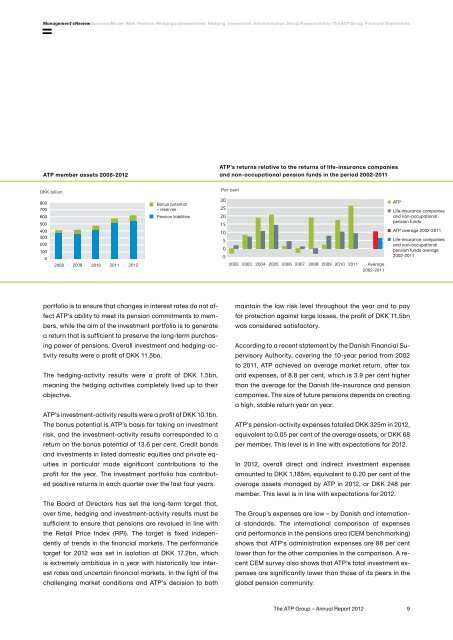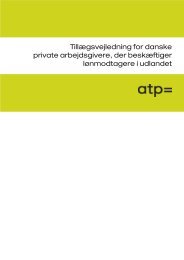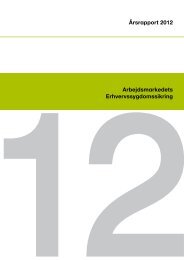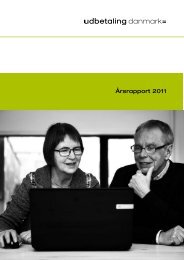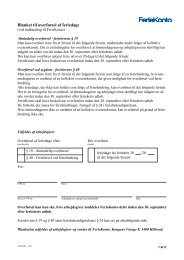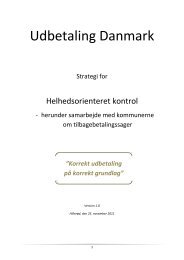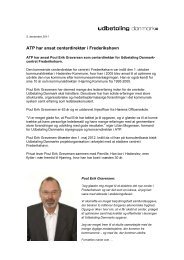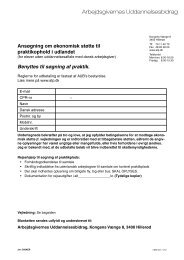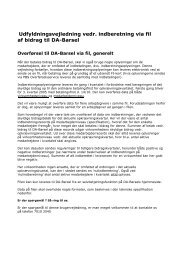The ATP Group Annual Report 2012
The ATP Group Annual Report 2012
The ATP Group Annual Report 2012
Create successful ePaper yourself
Turn your PDF publications into a flip-book with our unique Google optimized e-Paper software.
Management's Review Business Model Risk Pension Hedging and Investment Hedging Investment Administration Social Responsibility <strong>The</strong> <strong>ATP</strong> <strong>Group</strong> Financial Statements<strong>ATP</strong> member assets 2008-<strong>2012</strong><strong>ATP</strong>’s returns relative to the returns of life-insurance companiesand non-occupational pension funds in the period 2002-2011DKK billionPer cent80070060050040030020010002008 2009 2010 2011 <strong>2012</strong>Bonus potential– reservesPension liabilities302520151050-52002 2003 2004 2005 2006 2007 2008 2009 2010 2011Average2002-2011<strong>ATP</strong>Life-insurance companiesand non-occupationalpension funds<strong>ATP</strong> average 2002-2011Life-insurance companiesand non-occupationalpension funds average2002-2011portfolio is to ensure that changes in interest rates do not affect<strong>ATP</strong>’s ability to meet its pension commitments to members,while the aim of the investment portfolio is to generatea return that is sufficient to preserve the long-term purchasingpower of pensions. Overall investment and hedging-activityresults were a profit of DKK 11.5bn.<strong>The</strong> hedging-activity results were a profit of DKK 1.5bn,meaning the hedging activities completely lived up to theirobjective.<strong>ATP</strong>’s investment-activity results were a profit of DKK 10.1bn.<strong>The</strong> bonus potential is <strong>ATP</strong>’s basis for taking on investmentrisk, and the investment-activity results corresponded to areturn on the bonus potential of 13.6 per cent. Credit bondsand investments in listed domestic equities and private equitiesin particular made significant contributions to theprofit for the year. <strong>The</strong> investment portfolio has contributedpositive returns in each quarter over the last four years.<strong>The</strong> Board of Directors has set the long-term target that,over time, hedging and investment-activity results must besufficient to ensure that pensions are revalued in line withthe Retail Price Index (RPI). <strong>The</strong> target is fixed independentlyof trends in the financial markets. <strong>The</strong> performancetarget for <strong>2012</strong> was set in isolation at DKK 17.2bn, whichis extremely ambitious in a year with historically low interestrates and uncertain financial markets. In the light of thechallenging market conditions and <strong>ATP</strong>’s decision to bothmaintain the low risk level throughout the year and to payfor protection against large losses, the profit of DKK 11.5bnwas considered satisfactory.According to a recent statement by the Danish Financial SupervisoryAuthority, covering the 10-year period from 2002to 2011, <strong>ATP</strong> achieved an average market return, after taxand expenses, of 8.8 per cent, which is 3.9 per cent higherthan the average for the Danish life-insurance and pensioncompanies. <strong>The</strong> size of future pensions depends on creatinga high, stable return year on year.<strong>ATP</strong>’s pension-activity expenses totalled DKK 325m in <strong>2012</strong>,equivalent to 0.05 per cent of the average assets, or DKK 68per member. This level is in line with expectations for <strong>2012</strong>.In <strong>2012</strong>, overall direct and indirect investment expensesamounted to DKK 1,185m, equivalent to 0.20 per cent of theaverage assets managed by <strong>ATP</strong> in <strong>2012</strong>, or DKK 248 permember. This level is in line with expectations for <strong>2012</strong>.<strong>The</strong> <strong>Group</strong>’s expenses are low – by Danish and internationalstandards. <strong>The</strong> international comparison of expensesand performance in the pensions area (CEM benchmarking)shows that <strong>ATP</strong>’s administration expenses are 88 per centlower than for the other companies in the comparison. A recentCEM survey also shows that <strong>ATP</strong>’s total investment expensesare significantly lower than those of its peers in theglobal pension community.<strong>The</strong> <strong>ATP</strong> <strong>Group</strong> – <strong>Annual</strong> <strong>Report</strong> <strong>2012</strong>9


